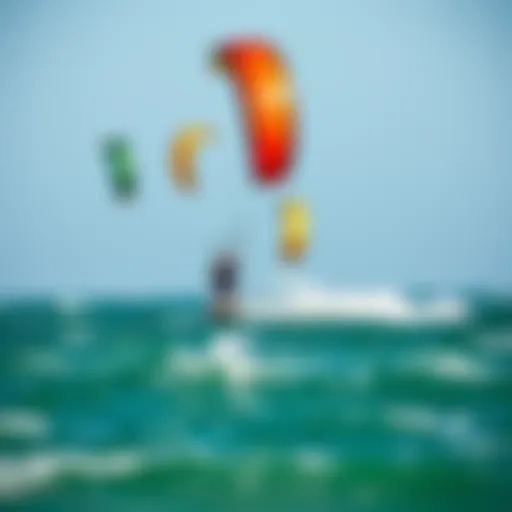Essential Wind Meters for iPhone in Kiteboarding


Intro
Kiteboarding thrives on the whims of the wind. Without understanding its patterns, one might as well be sailing against the current. Enter the wind meter, a tool that can mean the difference between a thrilling session and a hazardous misadventure. For kiteboarders, particularly those armed with an iPhone, having access to reliable wind data is not just a convenience, it's a safety measure. In this article, we’ll delve into how wind meters designed for iPhones can elevate kiteboarding experiences, shedding light on the applications available, their accuracy, and tips for making the right choice when selecting a device.
Understanding how wind affects kiteboarding is crucial. It’s not merely about having strong winds; it’s about recognizing the subtleties—like gusts, steady patterns, and shifts in direction. Each of these factors can determine whether you will soar through the skies or end up stuck on land.
In this guide, we'll explore the following aspects to empower kiteboarders:
- Gear Insights, including reviews and essential gear recommendations for novices.
- Techniques and Tips for mastering the sport and ensuring safety on the water.
With the help of accurate data and the right tools, kiteboarders of all levels can make informed decisions to enhance their time on the water.
Foreword to Wind Meters
In the world of kiteboarding, where the whims of nature dictate the experience, understanding wind conditions becomes paramount. Wind meters for iPhone have emerged as essential tools not only for seasoned kiteboarders but also for novices eager to ride the waves efficiently. This section aims to dissect the significance of these devices.
Understanding Wind Measurements
To grasp the utility of wind meters, one must first comprehend how wind is measured. Wind speed is typically expressed in miles per hour (mph) or meters per second (m/s), while wind direction is indicated by angles measured from magnetic north. Today’s digital devices are capable of not only measuring these variables but displaying them in real time, allowing for immediate adjustments. For kiteboarders who thrive on accuracy, the implementation of wind measurements can be a game-changer. The scale of measurement - be it an anemometer or a mobile application - plays an instrumental role in kiteboarding.
Using the iPhone for such measurements comes with numerous advantages, including portable convenience and immediate access to data, empowering practitioners to make informed decisions. Knowing when the wind is favorable can mean the difference between a thrilling ride and a frustrating day. Furthermore, understanding the nuances of wind patterns helps in selecting proper equipment and techniques, elevating the overall kiteboarding experience.
The Role of Wind in Kiteboarding
Wind isn’t just a background actor in kiteboarding; it’s the star of the show. The power of the wind propels the kite and determines the way a session unfolds. With sustained knowledge of wind conditions, riders can optimize their skills, showcasing techniques that assert the synergy between the kite and nature’s breath. Understanding wind conditions allows athletes to select the right size kite, adjust their flying style, and even choose the right time of day for their sport.
The consequences of misjudging wind can lead to sobering situations on the water. An unexpected gust can catch an unprepared kiteboarder off guard, or a lull can diminish momentum, abruptly halting a ride that could’ve been exhilarating.
In summary, wind meters for iPhone serve as not just gadgets but as critical companions for kiteboarders. They provide something that every adventurer crave: knowledge.
"Wind meters are an extension of our senses, helping us read the invisible and sculpt our ride accordingly."
As we journey through the intricacies of wind meters, it's essential for enthusiasts to appreciate their significant role in enhancing safety, ensuring effective decision-making, and ultimately enriching the kiteboarding experience.
iPhone Compatibility
The compatibility of wind meter applications with iPhone devices is crucial for kiteboarders seeking timely and accurate wind data. It can make or break your kiteboarding session. Opting for tools that seamlessly integrate with your iPhone not only enhances your experience but also brings a layer of reliability, which is essential when every gust of wind counts.
Supported Devices and iOS Versions
When it comes to wind meter apps, not every iPhone is created equal. You'll want to check which devices support specific applications. Many modern wind apps function best on iPhone 8 and later models due to enhanced sensors and better performance features. Apple continually updates its operating system, so keeping your iOS version current—ideally, using the latest iOS—ensures optimal compatibility. Not only does newer software allow for bug fixes and improved functionalities, but it can also enhance the app's ability to read wind data accurately.
Here's a quick rundown of popular wind meter apps and their compatible iPhone models:
- Anemometer: Best for iPhones from 7 onward.
- Windy: Compatible with iPhone SE and newer, taking full advantage of newer GPS capabilities.
- Kite Mobile: Works well with iPhone 8 and above for its real-time updates.
Always check the app store description for your device compatibility, as updates can shift the requirements.
Integration with Other Apps
Wind meter apps that play well with other software tend to offer a richer experience. Many kiteboarders find real value in integrating their wind data with navigation or weather apps. For instance, using a wind meter app in tandem with a weather forecasting app gives you a clearer picture of what to expect on your outing.
Additionally, synchronization with social media platforms can offer advantages too. You may want to share your kiteboarding adventures on platforms like Facebook or Instagram or even engage with fellow kiteboarders on Reddit for advice and tips. This social element can enhance your kiteboarding experience, making it more community-oriented.
Moreover, some of these apps can share data with fitness trackers, enabling enthusiasts to document their kiteboarding sessions. Imagine glancing at your watch during a session to see how many jumps you've made and at what wind speeds! It's these innovations that not only make every outing more enjoyable but also promote safe practices.
In summary, knowing which iPhone devices are compatible and how wind meter apps integrate with other applications can significantly enhance your kiteboarding experience, making your time on the water enjoyable and worry-free.
Types of Wind Meter Apps
In the realm of kiteboarding, understanding wind conditions is paramount. While traditional devices like anemometers have served this purpose, the advent of smartphone technology has paved the way for specialized wind meter apps tailored for the iPhone. This section delves into the various types of wind meter apps, noting the benefits and distinct considerations of each type. Whether you’re a beginner just getting your feet wet or an experienced rider chasing the perfect wind, knowing what these apps offer can profoundly enhance your kiteboarding experience.
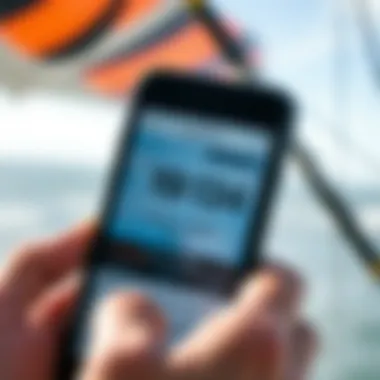
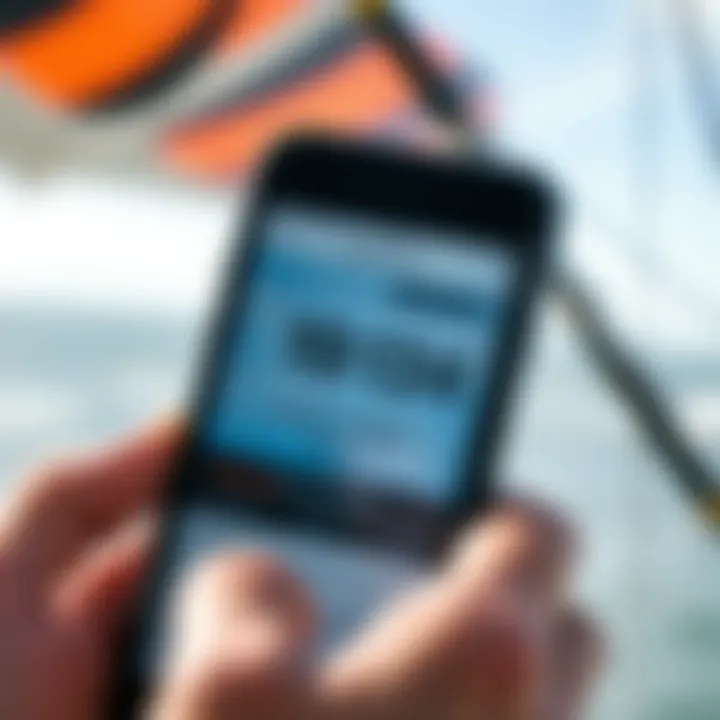
Basic Wind Measurement Apps
Basic wind measurement apps fundamentally serve their purpose by providing essential wind data. They generally focus on measuring parameters such as wind speed and direction. For kiteboarders, these apps are invaluable in determining whether conditions are suitable for riding. Most of these apps are user-friendly, making them accessible even for those who are not tech-savvy. Common offerings include simple displays of wind speed in miles per hour or meters per second, and a compass-like feature to indicate wind direction.
A popular choice in this category is Windy. This app not only provides fundamental wind measurements but also integrates weather forecasts to help you plan your sessions better. Another notable mention is Wind Speed, a straightforward app that delivers real-time wind data and is particularly light on battery consumption, crucial for those long days out on the water.
Benefits of Basic Wind Measurement Apps:
- Easy to use with minimal setup required.
- Quick access to essential wind metrics.
- Ideal for novices who need reliable data without overwhelming detail.
However, while the simplicity of these apps is an asset, they may lack the depth of analysis offered by their more advanced counterparts. For instance, they might not track historical data or provide sophisticated visualizations, leaving some kiteboarders wanting more.
Advanced Wind Analytics Apps
On the flip side, advanced wind analytics apps cater to seasoned kiteboarders who crave detailed insights and analytics. These apps often include a wealth of features, from live updates to complex graphs that display wind trends over time. For example, apps like KiteBuddy not only measure wind but also give you comprehensive weather data, including temperature, humidity, and barometric pressure, essential factors that can influence your ride.
One particularly sophisticated option is iKitesurf, which provides detailed forecasts, real-time wind alerts, and the ability to create specific metrics based on your rides. This sort of information can be a game changer when fine-tuning your kite setup, ensuring you go out only when conditions are optimal.
Benefits of Advanced Wind Analytics Apps:
- Detailed data visualizations allow for better forecasting of wind patterns.
- Historical data functionality helps in understanding past conditions that led to successful rides.
- More suitable for experienced riders who want data-driven insights to enhance performance.
However, these advanced apps may come with a learning curve and could be overwhelming for those just starting out. Yet, investing time in understanding them can yield significant returns on your riding performance and safety.
Features to Look for in a Wind Meter App
When diving into the world of kiteboarding, the wind meter app on your iPhone transforms from a mere accessory into a crucial tool in your kiteboarding arsenal. Understanding the features that set these apps apart can change your entire riding experience. The right wind meter app isn't just about raw wind data; it elevates your ability to navigate, perform, and, most importantly, stay safe on the water. Here are key features that deserve a close look.
Real-Time Data Tracking
Nothing beats the thrill of that perfect gust when you’re out kiteboarding. However, it's essential to have the right information at your fingertips to make the most of those moments. Real-time data tracking in wind meter apps function like a lighthouse guiding your journey in choppy waters.
These apps provide continuous updates on wind speed and direction, empowering you to make snap decisions mid-ride. Consider scenarios where wind can suddenly shift. If you are armed with real-time updates, you can adjust your kite's position or even decide to land safely before conditions worsen.
To make sure you’re getting the best data, opt for an app that includes:
- Instant notifications: Alerts you when wind conditions change rapidly.
- Live wind graphs: Visualizes how wind strength varies in real-time, helping you anticipate shifts.
"In kiteboarding, understanding the wind is not just beneficial; it can be the difference between a memorable day on the water or a painful tumble."
Historical Data Functionality
While real-time data is splendid, it only tells part of the story. Historical data functionality allows you to tap into previous wind conditions, giving you a more holistic understanding of what to expect in specific spots.
Imagine heading to your favorite kiteboarding beach and checking historical data from the last month or even the past year. Knowing how wind conditions fluctuate over time can help you plan not just day-to-day trips but even more extended vacations. Plus, it’s a handy feature for instructors scouting locations suitable for lessons or for assessing challenges each position may present.
Look for features like:
- Past wind trends: Graphs showing wind speeds, gusts, and shifts over time.
- Location-specific data: Historical tracking for your favorite kiteboarding spots.
User Interface and Usability
An app can be packed with features yet fall flat if it is a pain to use. A clean, intuitive user interface is fundamental in keeping you focused on the waves and not fumbling through menus.
Consider how quickly you can access information when conditions shift. If you’re putting your kite in the sky and trying to recall the average wind speed of the last hour, a convoluted interface can create unnecessary stress.
Examine:
- Visual clarity: Easy-to-read data on wind speeds, direction, and trends.
- Customization options: Tailor alerts and dashboards based on what matters most to you.
In this fast-paced sport, the ease of use can enhance overall enjoyment and performance, ensuring all your attention is directed where it should be—on riding the wind and mastering the skies.
Accuracy of Wind Measurements


When kiteboarding, the wind is your lifeline, and being precise about its conditions is crucial. The accuracy of wind measurements influences everything from your performance to your safety while out on the water. Accurate readings can spell the difference between a thrilling ride and a dangerous mishap. It’s essential to grasp how and why to measure the wind correctly, especially when you're relying on mobile apps and devices.
Factors Affecting Accuracy
Several elements can sway the accuracy of wind readings captured by an iPhone. Here are some core factors to consider:
- Environmental Conditions: Wind conditions in your area can be quite different than reported. Trees, buildings, or other obstructions can create wind shadows, which may lead to false readings. In such cases, the measurement may not reflect the true wind you will experience while kiteboarding.
- Sensor Quality: The nature and quality of the sensors integrated into mobile devices can vary significantly. An iPhone generally has reliable sensors, but variances do exist. The phone's positioning can also change the readings; holding it at an angle, or having it in a pocket could compromise the data.
- Calibration: The functionality of your wind meter relies heavily on its calibration. Failures in this process can lead to discrepancies in data. Comparing your readings with established benchmarks is wise to check the device’s performance in real time.
Understanding these factors not only sets the foundation for accurate measurements but also enhances your overall kiteboarding experience.
Calibration Processes
Calibration is arguably the cornerstone of accurate wind measurement. Without it, readings can be as reliable as a weather forecast that predicts sunshine during a blizzard. Here are the steps to ensuring your wind meter is properly calibrated:
- Initial Setup: Before taking your device out for the first time, ensure that your app is set up correctly. Some applications may have built-in calibration options. Follow the steps indicated to get optimal settings.
- Measurement Comparison: At a stationary location—preferably one you know well—compare the wind meter readings from your iPhone with those from a standard professional wind gauge, like those used in meteorological facilities. This step can point out any noticeable discrepancies.
- Routine Checks: Continue to check the calibration periodically, especially after traveling to new locations. Different terrains can skew your measurements.
In the long run, maintaining regularly calibrated devices ultimately allows you to make informed decisions based on reliable data.
Comparing with Professional Instruments
While mobile apps and wind meters designed for iPhones are convenient, they don't always stack up against professional instruments. There are some things to bear in mind when comparing the two:
- Precision: Professional wind meters often provide real-time, highly precise measurements that can exceed the input from most mobile applications. High-end devices capture minute fluctuations which are important for serious sports enthusiasts.
- Range of Functions: Professional instruments can offer features like wind direction indicators, temperature adjustments, and altitude effects, which mobile apps tend to lack.
- Data Longevity: Many professional wind measuring devices can store extensive historical data, which can be beneficial for studying long-term weather patterns in your area. In contrast, mobile apps may rely on cloud storage and thus require an internet connection for accessing historical data.
While mobile wind meters are excellent for on-the-go calculations, serious kiteboarders may wish to invest in professional equipment for the most critical measurements. Ultimately, integrating both professional devices and mobile apps could yield the most comprehensive insights into wind conditions.
Practical Applications for Kiteboarders
When it comes to kiteboarding, understanding wind conditions is as crucial as knowing how to control your board. Wind meters for iPhone play a significant role in ensuring kiteboarders make informed choices about when and where to ride. Relying on accurate data can be the make-or-break factor in having an enjoyable session or facing unsafe conditions. This section will dissect the practical applications of using wind meters and their advantages, shedding light on how these tools are invaluable for everyone from novices to seasoned riders.
Determining Ideal Wind Conditions
For kiteboarders, wind is the lifeblood of the sport. Winds can vary unpredictably, and a reliable wind meter app can help users determine the ideal conditions to hit the water. Factors such as wind speed and direction play a pivotal role in achieving that exhilarating ride.
- Understanding Wind Speed: Each kite has its ideal wind speed range. For example, small kites tend to perform better in strong winds, while larger kites are designed for lighter breezes. By using a wind meter, kiteboarders can check the current wind speed, ensuring they’re suited up with the right equipment.
- Real-Time Updates: Good wind meter apps offer real-time data, allowing riders to respond instantly to changing conditions. If winds begin to pick up or drop, it’s crucial to know when to adjust or even retreat, avoiding potential risks.
- Local Conditions: Not every spot is created equal when it comes to wind flow. Using wind meter apps helps track localized weather patterns, which can significantly differ from general forecasts. Riders can gain insights into their turf, helping them to understand their favorite kiteboarding locations better.
A wind meter isn't just a gadget—it's a lifeline to safer and more thrilling adventures on the water.
Enhancing Safety and Decision-Making
Safety can never be overlooked in adventure sports, especially one as dynamic as kiteboarding. Wind meters can significantly improve decision-making processes by providing data that kiteboarders rely on for assessing risks effectively.
"Knowledge is power; it’s your best friend on the water."
- Assessing Conditions: When planning a kiteboarding session, knowing the wind conditions can help in making critical decisions. There’s a fine line between challenging conditions that are invigorating and those that are dangerous. Wind meters help consumers gauge the feasibility of their plans.
- Better Communication: When kiteboarders share real-time wind data with their peers, it fosters better communication and coordination within groups. Everyone can be on the same page regarding safety, making joint decisions on whether to proceed or call it a day.
- Preparation for Emergencies: If the wind picks up unexpectedly, having a wind meter allows riders to react quickly, evacuating the area if necessary. This feature is especially useful for instructors or those teaching others to kiteboard, as they must prioritize the safety of their students as well.
In a world where conditions can shift in a heartbeat, using wind meters not only empowers kiteboarders but equips them with the intelligence they need to stay safe and make informed choices. By incorporating these tools into their routine, riders enhance their kiteboarding experience exponentially.
For kiteboarders, the right information can turn a risky situation into a memorable ride, delivering the thrill of the sport while keeping safety at the forefront.
Tips for Effective Use
When it comes to kiteboarding, having the right tools can make a world of difference. Among these tools, wind meters for iPhone stand out as essential for gauging wind conditions accurately. In this section, we’ll dive into tips that can help kiteboarders optimize their use of these mobile devices to enhance their kiteboarding experience. Understanding these tips is not just about data collection; it’s about making informed decisions that can significantly affect performance and safety on the water.
Optimizing Sensor Placement
The placement of your wind meter sensor can greatly influence the accuracy of the readings. Ideally, the sensor needs to be positioned where it can receive unobstructed wind flow for the best results.
Here are a few considerations:
- Avoid Obstacles: Make sure the sensor is away from trees, buildings, or large equipment that could distort the wind reading. Even a small obstruction can lead to incorrect measurements, which can impact your decision-making.
- Height Matters: Generally, placing the sensor higher above the ground can yield a clearer data set, as it is less affected by turbulence created by ground-level structures. You might want to consider attaching it to your kite or a high pole if you’re setting up for a session at a specific location.
- Use in Various Conditions: Experiment with the sensor in different wind conditions at various placements. What works in light wind may not apply in stronger winds, so understanding your environment is crucial.
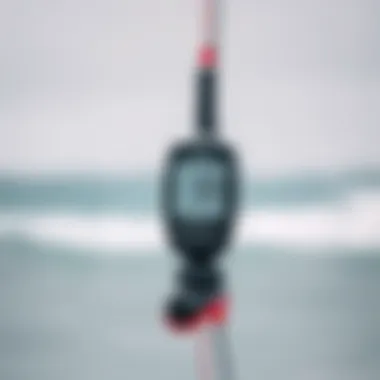
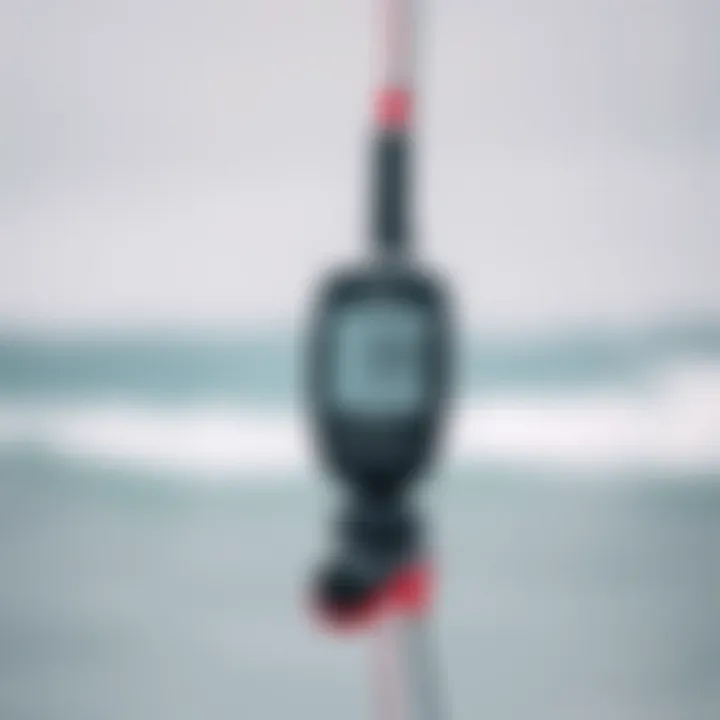
Interpreting Wind Data Accurately
Understanding the data from your wind meter is just as important as how you collect it. Kiteboarders must interpret incoming data accurately to ensure safety and performance.
To effectively analyze wind data, consider the following:
- Understand Measurement Units: Familiarize yourself with the units being used by the app—whether it’s kilometers per hour, miles per hour, or knots. Knowing the difference enables you to make quicker decisions when the wind conditions change.
- Pay Attention to Trends: Wind conditions can fluctuate rapidly. Instead of fixating on a single reading, monitor trends over a short period. Look for patterns in wind behavior, such as gusts or lulls, to make informed decisions.
- Balance Real-Time Data with Historical Context: While real-time data is valuable, don’t neglect historical wind data. Comparing current conditions with past performance can reveal how various wind conditions affect your riding experience.
"Data doesn’t mean much until you know how to read it. Select the right information, and it becomes your best ally on the water."
Incorporating these tips will not only enhance your experience but can also increase your safety while kiteboarding. Being informed and prepared shifts the odds in your favor, allowing you to ride with confidence.
Limitations of Mobile Wind Meters
Mobile wind meters have certainly revolutionized the way kiteboarders approach their sport, bringing convenience right to their fingertips. However, they aren't without their caveats. Understanding these limitations is crucial, particularly for kiteboarders who rely on accurate wind data to make informed decisions. Let's delve into some specific aspects that define the limitations of these handy devices.
Dependence on Environmental Factors
One of the foremost limitations of mobile wind meters is their reliance on environmental factors. Unlike stationary meteorological devices placed strategically in open areas, mobile wind meters can be influenced significantly by their immediate surroundings. For instance, if you're measuring wind speed near tall buildings or dense foliage, the readings may not reflect the true wind conditions. This phenomenon, often called wake turbulence, can distort the data these devices provide, skirting the edges of reliability.
Additionally, temperature and humidity can also sway measurements. As a kiteboarder, you might find that a calm afternoon turns into unexpectedly gusty conditions as the sun sets. If your mobile device does not account for these changing variables adequately, you could be left in a tight spot—literally. Surveying your launch site for obstacles and being aware of the specific microclimates in your area can go a long way in getting more accurate readings from your mobile wind meter.
Comparative Limitations with Stationary Devices
When you juxtapose mobile wind meters with stationary devices, the differences are stark. While mobile options provide portability and accessibility, they often fall short in terms of precision and data consistency. Stationary weather stations are designed with high-quality sensors and can constantly monitor wind patterns, while mobile wind meters rely heavily on the user to capture data as they move.
For example, a standard professional-grade anemometer mounted on a tower can provide real-time data over a wide area, covering aspects like gust duration and wind shifts. In contrast, a mobile app may only give you snapshots of wind velocities with less context. This is particularly crucial when you're in a sport like kiteboarding where you need to recognize patterns over time to enhance your performance.
To sum it up, while mobile wind meters serve their purpose well, they are not foolproof. Factors like environmental obstructions can lead to misleading measurements and when compared to professional stationary instruments, these mobile devices often lag in providing the depth and breadth of data needed for optimal kiteboarding. It's essential for enthusiasts to be aware of these limitations so they can make informed choices on the water and navigate wind conditions more effectively.
Future Trends in Wind Meter Technology
As kiteboarding continues to gain popularity, so does the integration of technology to enhance the experience. Wind meters designed for the iPhone have evolved significantly, and upcoming trends push this evolution to new heights. Understanding these trends is crucial for kiteboarders who wish to stay ahead in the sport while making informed decisions about their gear.
Integration of AI and Machine Learning
Artificial intelligence (AI) and machine learning are revolutionizing the way wind meters function. These technologies allow apps to analyze vast amounts of wind data, providing insights that were previously unattainable. Imagine a wind meter that can learn from past weather patterns and predict the best times for kiteboarding at your favorite spots. This is not science fiction; it’s becoming a reality.
- Predictive Analytics: Apps equipped with AI can forecast wind conditions based on historical data, which helps users anticipate changes in wind speed and direction.
- Personalized Recommendations: Through user feedback and preferences, AI can tailor suggestions for optimal riding conditions, contributing to a more enjoyable experience on the water.
As technology evolves, kiteboarders can look forward to tools that not only measure but also predict favorable conditions tailored to individual skill levels.
Advancements in Sensor Technology
On the ground level, sensor technology is also advancing at an impressive rate. Modern wind meters are becoming increasingly sophisticated, enabling more accurate measurements. These advancements lead to a more reliable kiteboarding experience.
- Miniaturization: Manufacturers are creating smaller and more efficient sensors while maintaining accuracy and functionality. This means that the wind meter can easily fit into your pocket or be seamlessly integrated into your gear.
- Enhanced Durability: New materials make sensors resilient against harsh environmental conditions, ensuring data remains reliable despite the elements. Whether you encounter saltwater, sand, or sudden weather changes, cutting-edge devices can withstand it all.
- Multi-Functionality: Future devices may combine wind measuring with other necessary data, such as wave height or temperature, providing a comprehensive overview of conditions specific to kiteboarding.
In summary, the future of wind meter technology for kiteboarding looks promising. With advancements like AI integration and improved sensor technology, kiteboarders can expect improved performance and more accurate decision-making aids. Staying informed about these trends can enhance both safety and enjoyment on the water, making each session worthwhile.
The End
In summing up the vital role that wind meters designed for iPhones play in kiteboarding, it's clear that these tools are indispensable for anyone serious about the sport. The ability to measure wind speed and direction accurately can’t be overstated; it's akin to having a compass in the wilderness. Without knowing the wind conditions, one might as well be flying blind, and that can lead to precarious situations on the water.
Summary of Key Points
To reiterate, the main takeaways from this article encompass multiple aspects:
- Importance of Wind Measurement: Knowing wind conditions is crucial for safety and performance. Being able to navigate this information effectively enhances the kiteboarding experience.
- App Compatibility: Many apps work seamlessly on iPhones. From basic wind measurements to advanced analytics, there’s an option for every level of kiteboarder.
- Features to Prioritize: When selecting a wind meter app, consider real-time data tracking, historical data access, and a user-friendly interface.
- Accuracy and Limitations: While mobile wind meters provide convenience, they must be understood within the context of their limitations compared to professional devices.
- Future Trends: As technology advances, integrating AI and improved sensor tech will likely bring even better capabilities to wind meters, making them more indispensable in kiteboarding.
In summary, understanding how to leverage these wind meters will undeniably enhance one’s kiteboarding pursuits, making wind measurements not just a fun technicality but a key element of the sport.
Call to Explore Available Options
Now that you've got a grasp of what to look for in a wind meter app for your iPhone, it’s time to dive into the options available. Here are some recommended actions:
- Explore the App Store for the latest wind meter apps that cater specifically to kiteboarding. Pay attention to user reviews and the features mentioned.
- Test different apps in varying conditions to find which one provides the most accurate data for your needs and preferences.
- Share experiences with fellow kiteboarders, whether at the beach or online platforms like reddit.com or even Facebook groups dedicated to kiteboarding. Engaging in those discussions can provide valuable insights and recommendations.
In closing, the appropriate wind meter not only enhances a kiteboarder's safety but also enriches the thrilling experience of gliding over water, making it all the more rewarding.















